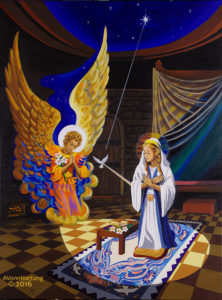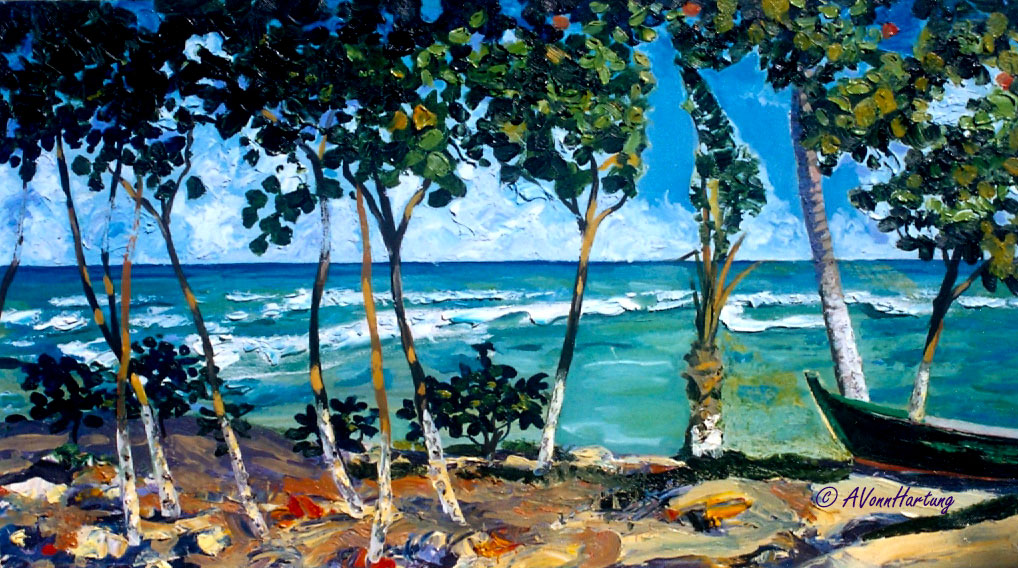(Scroll down for Spanish text)

Deep in the night with the Star of Jesus centered in the sky, Mary is in prayer, surrounded by the symbols of her faith. She prays that in some small way she might serve in the coming of the promised Messiah. Suddenly her prayers are answered!
The ceiling opens!
The Archangel Gabriel descends in divine glory and declares the message from God the Father. After pondering the words and their meaning deeply in her heart, Mary gives her consent.
At that very moment, she is filled with the luminous light of grace. She vows to fulfill the will of the Father and to deliver His only Son, incarnate as Jesus Christ, into the world according to His divine plan for our salvation.
A Vonn Hartung created this painting (acrylic 36″x 60″) for EWTN (UK)’s new welcoming center at the National Shrine of England (Mary’s House of Nazareth) in the village of Walsingham. The painting is an interpretation of the visions which Blessed Anne Catherine Emmerich (Augustinian Nun) received in 1821. Additionally, the artist has added symbolism to enhance and clarify the spiritual and prophetic consequences of the Annunciation Event.
SYMBOLISM IN THE PAINTING
The opening of the roof exposes the open sky. Here we see the constellations of Virgo and Leo and the location of the holy house in Nazareth. The Star of Jesus, better known as the Star of Bethlehem, signifies the presence and the will of the Father.
Mary’s Halo shows an ethereal lightening, a shimmering of the atmosphere around her head. This indicates her divine nature, her luminosity, and her state of grace.
The Scroll on the prayer table symbolizes the prophecy of Isaiah. (“Behold a virgin shall conceive, and bear a son, and his name shall be called Immanuel” Isaiah 7:14).
Mary’s belt shows a symbol of the Fetus.
The Three Lilies on the prayer table remind us of Joseph’s promise to honor Mary’s vow of virginity and dedication to the Lord.
The Three Lilies carried by the archangel Gabriel are a sign of the fulfillment of her vow and a blessing of her faithfulness.
The Rug (woven in lamb’s wool) represents Mary’s faith and prayer life. Its design emanates from and surrounds the Star of Jesus. (“For we have seen his star in the east…” Matthew 2:2) Significantly, it is composed of symbols and scenes from the life of Christ to come.
The design of the Floor Tiles symbolizes the flow that spread the Christian Faith from nation to nation throughout the world. (“Go ye and teach all nations baptizing them in the name of the Father, and the Son, and of the Holy Spirit” Matthew 28:19).
The Fireplace is a symbol of the home and family, of warmth, well-being, and security.
The Drawn Curtain on Mary’s bed reminds us of the torn veil of the temple (Matthew 27:51). Hence, it is a symbol of hope, reminding us of Christ’s sacrifice on the cross, death and resurrection, and promise of eternal life. The faint spectrum of color emanating from the curtain is a symbol of revelation.
The Hope Chest beneath the bed reminds us of the simplicity and humble social status of Mary. This young bride of Joseph the Carpenter will become the Mother of God.
Amen
THE WALSINGHAM STORY
“In 1061, the widow of the lord of the manor of Walsingham (Richeldis de Faverches) had a series of visions of the Virgin Mary, who showed her the house in Nazareth where the angel Gabriel made his revelation of the forthcoming birth of Jesus. Our Lady asked Richeldis to build a replica of the holy house in Walsingham.” It was a time when visiting the Holy Land was extremely dangerous, so this replica of Mary’s House would afford English Christians the opportunity to pay homage to her house in their own country. Walsingham became the premier shrine, and a large Christian community and monastery grew in its proximity.
“During medieval times, thousands of pilgrims from all over Britain and Europe visited Walsingham, including nearly all the kings and queens of England from Henry III (c. 1226). Royal visits continued right up to Henry VIII (1511). Then came the Reformation in 1538.”
When the pope refused to grant him a divorce from Catherine of Aragon, Henry VIII ordered the destruction of Mary’s House in 1538. It was burned to the ground, and the statue of Our Lady was taken to London to be destroyed.
Today, 350,000 pilgrims annually visit the Shrine at Walsingham
“When England returns to Walsingham, Our Lady will return to England.”
Buy a giclee print of this painting

En lo profundo de la noche, con la Estrella de Jesús centrada en el cielo, María está en oración, rodeada de los símbolos de su fe. Ella ora para que de alguna pequeña manera pueda servir en la venida del Mesías prometido. ¡De repente sus oraciones son respondidas!
¡El techo se abre!
El Arcángel Gabriel desciende en gloria divina y declara el mensaje de Dios Padre. Después de reflexionar profundamente en su corazón, las palabras y su significado, Mary da su consentimiento.
En ese mismo momento, ella se llena de la luz luminosa de la gracia cuando promete cumplir la voluntad del Padre y entregar a Su único Hijo encarnado como Jesucristo en el mundo de acuerdo con Su plan divino para nuestra salvación.
La pintura original mide 3 x 5 pies, acrílico sobre lienzo. Pinté este lienzo para el Santuario Nacional de Inglaterra en Walsingham (haga clic en el enlace para leer más). Es mi interpretación de una visión que la Beata Anne Catherine Emmerich (Monja Agustina) tuvo en 1821. Está en el Centro de Acogida de EWTN para peregrinos en Walsingham, Reino Unido. Además, el artista ha añadido simbolismo para realzar y aclarar las consecuencias espirituales y proféticas del acontecimiento de la Anunciación.
SIMBOLISMO EN LA PINTURA
La abertura del techo deja al descubierto el cielo abierto. Aquí vemos las constelaciones de Virgo y Leo y la ubicación de la santa casa en Nazaret. La Estrella de Jesús, más conocida como la Estrella de Belén, significa la presencia y la voluntad del Padre.
El Halo de María muestra un resplandor etéreo, un resplandor de la atmósfera alrededor de su cabeza. Esto indica su naturaleza divina, su luminosidad y su estado de gracia.
El Rollo sobre la mesa de oración simboliza la profecía de Isaías: (“He aquí que la virgen concebirá y dará a luz un hijo, y se llamará Emanuel” Isaías 7:14).
El cinturón de María muestra un símbolo del Feto.
Los Tres Lirios en la mesa de oración nos recuerdan la promesa de José de honrar el voto de virginidad y dedicación de María al Señor.
Los Tres Lirios que lleva el ángel Gabriel son un signo del cumplimiento de su voto y una bendición de su fidelidad.
La Alfombra (tejida en lana de cordero) representa la fe y la vida de oración de María. Su diseño emana de la Estrella de Jesús y la rodea. (“Porque hemos visto su estrella en el oriente…” Mateo 2:2). Significativamente, está compuesta por símbolos y escenas de la vida de Cristo venidero.
El diseño de las Baldosas simboliza la corriente que difundió la fe cristiana de nación en nación por todo el mundo. (“Id y haced discípulos a todas las naciones, bautizándolas en el nombre del Padre, y del Hijo, y del Espíritu Santo” Mateo 28:19).
La Chimenea es símbolo del hogar y la familia, de calidez, bienestar y seguridad.
La cortina corrida sobre el lecho de María nos recuerda el velo rasgado del templo (Mateo 27:51). Por lo tanto, es un símbolo de esperanza, que nos recuerda el sacrificio de Cristo en la cruz, su muerte y resurrección, y la promesa de vida eterna. El tenue espectro de color que emana de la cortina es un símbolo de revelación.
El baúl de la esperanza debajo de la cama nos recuerda la sencillez y el humilde estatus social de María. Esta joven esposa de José el Carpintero se convertirá en la Madre de Dios.
Amén
LA HISTORIA DE WALSINGHAM
En 1061, la viuda del señor del feudo de Walsingham (Richeldis de Faverches) tuvo una serie de visiones de la Virgen María, quien le mostró la casa de Nazaret donde el ángel Gabriel le reveló el inminente nacimiento de Jesús. Nuestra Señora le pidió a Richeldis que construyera una réplica de la santa casa en Walsingham. Era una época en la que visitar Tierra Santa era extremadamente peligroso, por lo que esta réplica de la Casa de María brindaría a los cristianos ingleses la oportunidad de rendir homenaje a su casa en su propio país. Walsingham se convirtió en el santuario más importante, y una gran comunidad cristiana y un monasterio crecieron en sus proximidades.
Durante la época medieval, miles de peregrinos de toda Gran Bretaña y Europa visitaron Walsingham, incluyendo a casi todos los reyes y reinas de Inglaterra desde Enrique III (c. 1226). Las visitas reales continuaron hasta Enrique VIII (1511). Luego llegó la Reforma en 1538. Cuando el Papa se negó a concederle el divorcio de Catalina de Aragón, Enrique VIII ordenó la destrucción de la Casa de María en 1538. Fue quemada hasta los cimientos y la estatua de Nuestra Señora fue llevada a Londres para ser destruida.
Hoy en día, 350.000 peregrinos visitan anualmente el Santuario de Walsingham.
«Cuando Inglaterra regrese a Walsingham, Nuestra Señora regresará a Inglaterra».
.
